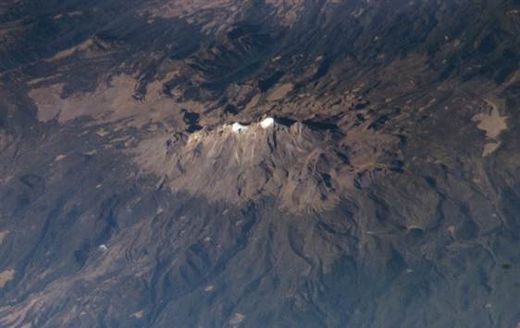
© NASAGlacial coverage is seen atop the Iztaccihuatl volcano in this satellite image from 2003.
Amecameca, Mexico - Glaciers that crown a Mexican volcano could disappear by 2015 with scientists pointing to global warming as a chief cause of their demise.
Until recently, the glacial field on Iztaccihuatl, a dormant volcano and one of two white-capped peaks that can be seen from Mexico City, was expected to be gone within a few decades.
But studies show rising world temperatures are melting the glaciers faster than previously thought, said Hugo Delgado, a glaciologist at Mexico City's UNAM university who thinks the massive blocks of ice will be gone within four years.
"What we've seen at Iztaccihuatl is an intense period of glacial retreat in the last few years, which has changed the picture," Delgado said.
Iztaccihuatl has one of two glacial fields left in Mexico, which are among the world's few tropical glaciers.
Glaciers are massive, slow-moving rivers of ice, and in the tropics they can only exist on the cold peaks of tall mountains. Most tropical glaciers, like those in Mexico, are much smaller than their cousins closer to the poles.
Glacial melt in the tropics could hit farmers and cities across Latin America by reducing water availability and hydro-power generation.
Scientists generally believe global warming is caused by large amounts of carbon dioxide released into the atmosphere when fossil fuels are burned.
The number of glaciers on Iztaccihuatl has dwindled from five to three, said Agustin Tagle, an official at the national park where Iztaccihuatl is located.
"The thickest was originally about 90 meters in depth," he said. "Now it is 10 meters at most."
Heat radiating from the sprawling, concrete-covered metropolis of Mexico City nearby is also contributing to the disappearance of the glaciers, Delgado said.
Iztaccihuatl, which means "white woman", was named by the Aztecs for the feminine form the mountain etched on the skyline and the snow and ice that covered it.
But snow falls are now scarce on the 17,000 foot peak, with vegetation growing at ever higher altitudes. It was extremely cold on Iztaccihuatl this week at a camp at 13,100 feet, however, with a raw wind hurling dust and ash across the mountain.
The volcano is a popular climbing destination but Roberto Flores, a local guide, said the disappearance of the glaciers has changed the experience. "We hardly need to use specialist equipment any more," said Flores, as he packed hiking poles into his truck after a climb.
"It's a shame because Iztaccihuatl used to be a technical climb comparable to some of the famous mountains of the Andes."

Reader Comments
to our Newsletter